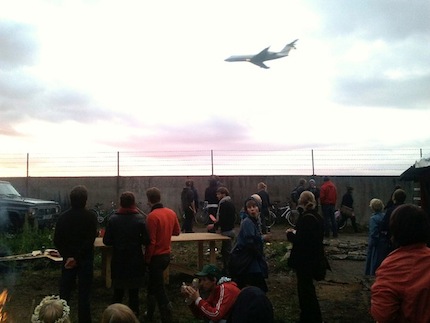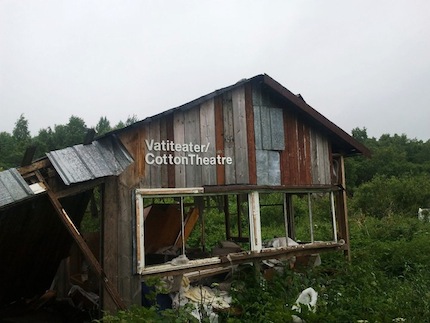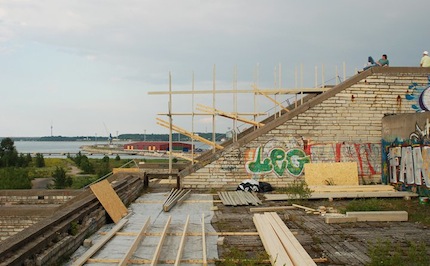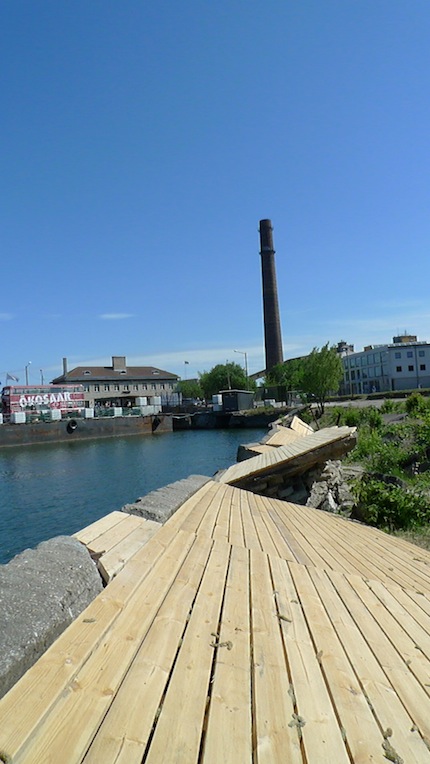
Lifting the Urban Environment
Anna Iltnere
15/07/2011
The urban installation festival, LIFT 11, has been taking place in Tallinn since the beginning of May and will go on until September 12; it is part of the program celebrating Tallinn as the European Capital of Culture for the year 2011. Ten installations are being gradually erected during the summer; they will all be finished by august and will be available for viewing until the end of the festival.
LIFT 11 is being organized by four curators: two architects – Margit Aule and Margit Argus from the architect association KAOS, and two art curators – Maarin Mürk, who is the founder of the art critique website artishok.blogspot.com, and is currently working on her doctoral dissertation; and Ingrid Ruudi, who curates architectural exhibitions, such as Estonia's pavilion at the 11th Venice Architecture Biennale in 2008, when a large, yellow gas pipeline was stretched across the Giardini. Ingrid Ruudi has also worked with the “Straw Theater” project, which is on display in Tallinn until the autumn; it is definitely something to go see this summer. (Read our article on the “Straw Theater” in the Arterritory.com archives).
The LIFT 11 projects were chosen through a competitive process; out of a total of 129 candidates, twelve came out on top. Only ten will be displayed, however, because City Hall later decided against two of the projects. The contest was open to those for whom Estonia has been a long-term place of residence. Most of the winners are artists and architects of Estonian heritage, but one of the installations was created by a Japanese architect, who has lived and worked in Tallinn for many years.
The curators were inspired to make a festival of the likes that Tallinn had never seen before, but were faced daily with the question: “Is Tallinn ready for something like this?” They realized that if they hadn't been taken under the wing of Tallinn as European Capital of Culture for 2011, such a festival would hardly see the light of day. Moreover, being a part of the Capital of Culture program added additional (though healthy) pressure and responsibility. It was a double-edged sword. But nevertheless, it was truly fortuitous, because the chosen works have turned out convincing.
Quite possibly, large thanks should be given to the close cooperation between the curators and the participants; together they analyzed and improved upon the chosen projects. All four curators note that none of the projects were perfect when first submitted. The architects were lacking in creative flight, but the artists characteristically failed to realize the scope of the urban environment, their works would virtually get lost within it.
Urban Sore
In the last several decades, the garden community of Soodevahe developed alongside Tallinn's airport. It has, however, long since gained the status of being illegal; since the fall of the Soviet Union, the land upon which the seasonal cottages have been built now belongs to the airport. But people, mostly Russian-speaking and of the older generation, continue to tend the gardens and spend their summers there. The division of garden plots has been done according to the principle of “the early bird gets the worm”, and is actually best described as squatting done by the elderly.
In May of this year, the airport authorities publicized plans to level a large part of the territory so as to increase the size of the runways. As the curators emotionally retell it – the locals will have just enough time to gather in the autumn harvest before the bulldozers come barreling in.

From one point of view, it is clear that the habitation of the area these last few years has been illegal, and the owner of the land has the right to do as he or she wishes. Soodevahe is like a suburban sore that occasionally oozes with sporadic violence. But it is also clear that the capital city is not only a tissue-wrapped top layer; there also exists a teeming world behind the scenes, naturally formed and interbred with the lives of those involved.
In such an apparently indisputable situation, when the village “inhabitants” don't have even a smidgin of legal rights to say a word in protest, the artist can be like a transistor that strengthens the signal and shows that this city neighborhood has existed, that it has meant something to a part of the population of Tallinn and that it is not just a dump with a bad reputation that will finally be paved over. The job of the artist is not to shout slogans and wave placards, but to show and document, through a subjective prism, that, which will soon be no more.
This struggle between the law and emotions can be well seen in the fact that the airport authorities are having a hard time finding workers willing, come autumn, to pull down the cottages and clear the land with their own hands.

The artist and programmer Timo Toots, who was nominated for the Estonian Contemporary Art Museum's Köler Prize 2011, and whose largest project to date is now visible in the KUMU Museum's electronic group exhibit “Gateways”, has “taken over” some of the abandoned village cottages. He has repainted them and done some minimal renovations and now, Soodevahe, for a while at least, has its own museum, bar, hotel and theater.
These institutions are mere decorations, of course. The idea is to show that this village has existed as a valuable neighborhood of the city, with its own infrastructure and local traditions. Timo Toots' establishments serve also as an information center not only to visitors, but also to the local inhabitants, allowing them to experience the unified oneness of the village.
Visiting Soodehave Village in the company of the curator Maarin Mürk, one gets a peculiar feeling. Unlike viewing art in museums and galleries, this place is more intense itself than the festival project that has been put therein.

On the way to our destinations, we don't see a single living soul; planes fly low and constantly, brambles alternate with erected cottages, which vary from “surrounded with brightly planted gardens” to “burned ruins”. Although Maarin has been here recently, her eyes give away a relentless curiosity to see what will await us around the next corner. Here there is a heavy, collapsed metal fence; elsewhere there are flowers growing where before there were none.

We carefully check the LIFT 11 objects to see what has been taken and what has been left. She says that during one visit, there were indications that someone had started to move into the “bar”. The village creates the impression that it is a living organism that ceaselessly, and rather uncontrollably, changes; the inhabitants naturally live with it, and the artist's installations give in to it. Wandering among the LIFT 11 cottages, Maarin texts Timo Toots a reminder that the area needs a bit of mowing.
The Cotton Theater leaves a special impression – a cottage where the only change the artist implemented is its name, which is written upon its facade. Everything else was left unchanged. It is this “feral” factor that gives extra power to the aesthetic enjoyment of it.

Photo: Anna Iltnere
It is not without reason that the theater is named so – the crooked building without walls or windows is full of stuffing. It hangs in strands from the ceiling, covers the floor in wads, and in the middle, there are a yet-untaken sofa and table. But the soft, white material is absolutely everywhere, making what has happened here utterly perplexing.
Maarin Mürk's call for a taxi to take us back to the city center adds another layer of atmosphere to Soodevahe Village. The first dispatcher she reaches replies that there is no such place.
A Lovely Catastrophe
Project “O”, the work of five people, is one large, black ball. It outsizes a person in height, but it is filled with air, so it's rather easily moved. A strong shove is all that's necessary to get it going. The creators of “O” are the artists Andra Aaloe, Flo Kaserau and the architects Aet Ader, Grete Soosalu and Kaarel Künnap, who is also a poet.
The authors' idea was to create an object that gains its meaning from the surrounding environment. In the narrowest of streets the ball seems huge – it blocks the way and people have to deal with the object somehow. By the sea or next to high-rises, “O” looks relatively small. The sphere can clumsily knock something over, or it can serenely and meditatively roll about. Its weight and material are also not easy to guess.
At first, the idea was to place it in the streets of Tallinn where, whether they want to or not, pedestrians would have to deal with it. The black ball would have to be rolled, pushed out of the way, or somehow squeezed by. But City Hall deemed the performance dangerous because the ball could roll unto the street, into the way of traffic. So the installation has been realized in a more organized manner – it is periodically moved to a specified location, and one of the authors must be present at all times and take responsibility that everything goes along safely.
“O” manages to faithfully fulfill its hoped-for role; while filming a television clip about the festival in Toompark, the big, black “catastrophe”was uncontrollable – it rolled into the bushes and bouncingly changed directions, contrary to the plans of the filming team.
The impressive ball “O” has also proved to be a successful marketing tool for the festival. I admit that when I was surfing through all of the information about the event and the accompanying barrage of images, I, too, was first hooked by the big, black sphere. During his visit to Riga, the Tate Galleries' Director of Audiences and Media, Marc Sands, pointed out that marketing must always choose the object that best catches the eye. It will create interest about the event as a whole, even though the individual may end up finding something completely different that catches their eye even more. But you must always have a hook.
“If It's Part Broke, Half Fix It”
The architect pair Siiri Vallner and Indrek Peil have cleverly, and with minimal financing, created a terrace that the city's inhabitants have already managed to fall in love with. It lies close to the harbor, by the “Cultural Kilometer” – a pedestrian street in the burgeoning cultural neighborhood where a railway line once used to run. It brings to mind the name of an exhibit at the CAC (Contemporary Art Center) in Vilnius - “If It's Part Broke, Half Fix It”.
Large slabs of broken concrete create a jagged shoreline at the former boat dock. Having assured themselves of the stability of the slabs, the architects have sheathed the concrete surfaces with wooden boards, creating an architecturally unusual terrace with the strange effect of looking as if it is broken.
Its authors point out that it is characteristic of today's architecture to experiment with defects. Architects invest large amounts of money to realize such visually deformed, but structurally stable forms. For the two Tallinners, this was an opportunity upon which to practice their skills, but on an already existing site and with “free” material. By the end of May, the boards of the terrace have already managed to fade a bit, visually improving it and thereby integrating the terrace into its environs even more.
Interestingly enough, the most angled of the concrete slabs, which seems rather unusable as a terrace, is the most popular among vacationers. It's steepness allows one to lean back, as if in a bed with a raised back, and gaze at the horizon out into the sea.

Temporary improvements have been implemented and are functioning, and the city hopes and promises to restore the yachting dock and to build cafes and additional terraces. While these ambitious plans are being bandied about, the locals already have a place to come together and enjoy the evening sun, courtesy of the Festival.
A Minimum of Beach?
Similar to the above-mentioned terrace, the beach project also shows how little work is actually necessary to improve the urban environment and the happiness of its inhabitants. A bit beyond the terrace – between Liinahall and the now-defunct city jail – is the local beach, Kalarand (transl. Fisherman's Beach). It is not registered as a legal place for swimming, but city dwellers come here to swim anyway.
Two urban activists, Teele Pehk and Triin Talk, and the architect and urban designer Toomas Paaver, have erected a changing room on the beach; they also put down a bench and covered two existing concrete blocks with wooden boards, creating two more tables/benches. They have done just enough to make the locals happy and to even increase the number of visitors to the site.

The goal of the project is not to encourage people to swim in an area off-limits to swimming, but to show that this zone is necessary for the city's shoreline. However, this doesn't fall in line with Tallinn's city planners' hopes of giving the beach over to the harbor for expansion, which would eliminate all possibilities (illegal or not) of cooling-off here in the summer.
A Japanese Architect and the Aura of a Soviet Building
Tomomi Hayashi is a Japanese architect who has lived and worked in Tallinn since 2001. He has brought several projects to fruition in the capital of Estonia; for instance, working along with several Estonian architects, he engineered the building that houses the Museum of Occupation. For the Festival, he is building a viewing terrace titled “To the Sea” – also alongside the harbor.

The wooden terrace will be an artificially made addition to the already existing soviet-era construction – Linnahall, which was built in the 1980's as the only spot where city dwellers could gain access to the sea. The high, concrete stairway ending with a wide platform at its top is still an impressive public building, and is a favorite meeting place for the city's inhabitants, especially the younger generation, and especially in summer. (The older generation tends to wrinkle their noses at it, saying it is a reminder of the now-gone regime).

Tomomi Hayashi admits that Linnahall's aura, with its beautiful view and sea breezes, speaks to him, and that is why he chose exactly this spot to create his urban installation.
The terrace, “To the Sea”, is finished and open from July 15.
Why not 12?
There are also installations that withstood the competition but were later vetoed by City Hall. One of the most hurtful bans, to both the curators and the artists, was announced just recently, when the installation was almost finished. The designer and installation artist Margus Tamm and the artist and product and interior designer Argo Peever had planned to improve upon the tzarist-Russian-built statue “Russalka” (transl. “Little Mermaid”), which lies close to Kadriorg Park, by adding a claustrophobic tunnel of steps that leads right up to the “Little Mermaid” and allows one to look into her eyes.
The approved projects' road to acceptance was also long, largely due to bureaucracy. This leads to the question – how open is the city to not only artistic events being held in the city's environment, but also to the active development of the urban landscape as such? Because the fact is that the number of people who have something to offer Tallinn is growing faster than the number of people from whom approval must be garnered. It is not for nothing that in several projects the word “illegal” has appeared; it makes one think about the dichotomy between the city's development, as guided by the city planners, and the way in which the city's inhabitants carry on their daily lives and rituals.
Photos: LIFT11








